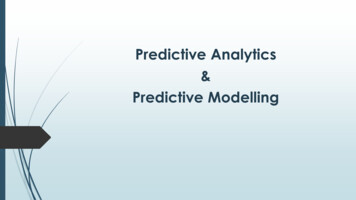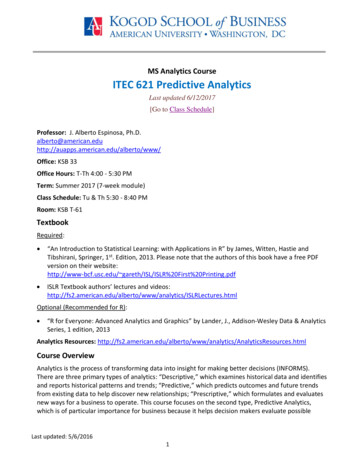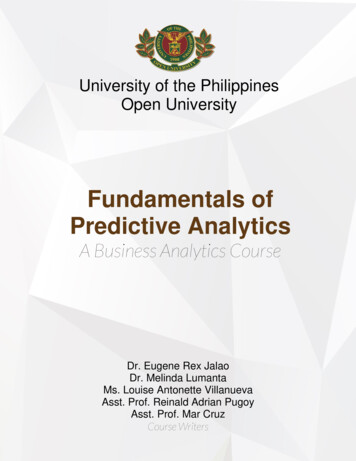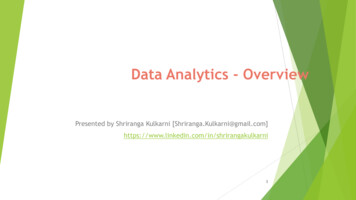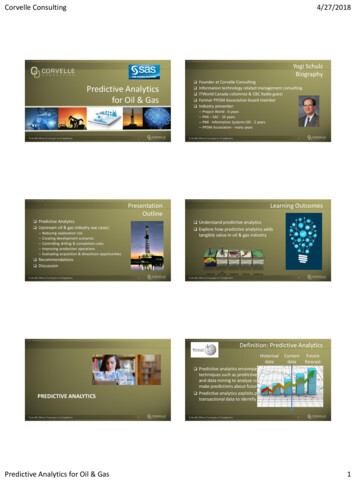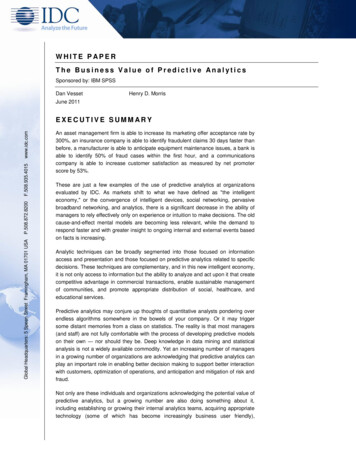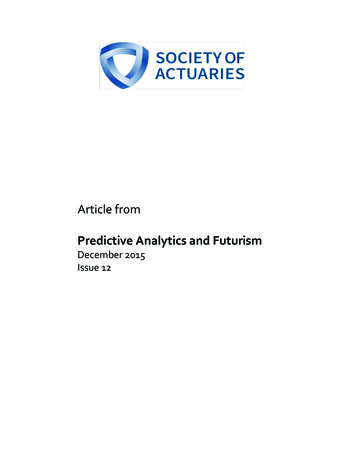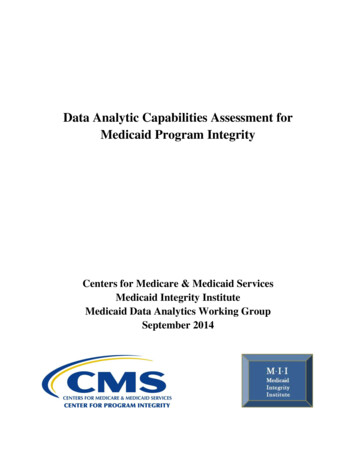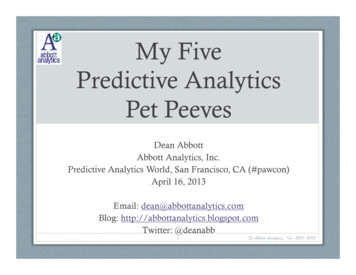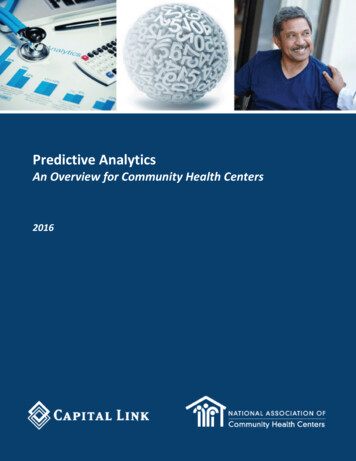
Transcription
Predictive AnalyticsAn Overview for Community Health Centers2016Predictive Analytics: An Overview for Community Health Centers1
AcknowledgementsThis project was supported by the Health Resources and Services Administration (HRSA) of theU.S. Department of Health and Human Services (HHS) under cooperative agreement numberU30CS16089, Technical Assistance to Community and Migrant Health Centers and Homelessfor 6,375,000.00 with 0% of the total NCA project financed with non-federal sources. Thisinformation or content and conclusions are those of the author and should not be construed as theofficial position or policy of, nor should any endorsements be inferred by HRSA, HHS, or theU.S. Government.About Capital Link:Capital Link is a non-profit organization that has worked with hundreds of Health Centers andprimary care associations for over 15 years to plan capital projects, finance growth, and identifyways to improve performance. We provide innovative consulting services and extensivetechnical assistance with the goal of supporting and expanding community-based health care.Additionally, Capital Link works in partnership with primary care associations, the NationalAssociation of Community Health Centers, and other entities interested in improving access tocapital for Health Centers. For more information, please visit www.caplink.org.About the National Association of Community Health Centers (NACHC):Federally Qualified Health Centers serve over 22 million people at more than 9,000 sites locatedthroughout all 50 states and U.S. territories. Because Health Centers serve patients regardless oftheir abilities to pay, they depend on public financial support and need a unified voice andcommon source for research, information, training, and advocacy. To address these needs,NACHC organized in 1971. NACHC works with Health Centers and state-based primary careorganizations to serve Health Centers in a variety of ways:Provide research-based advocacy for Health Centers and their clients.Educate the public about the mission and value of Health Centers.Train and provide technical assistance to Health Center staff and boards.Develop alliances with private partners and key stakeholders to foster the delivery ofprimary health care services to communities in need.As a founding partner of Capital Link, NACHC appoints some of Capital Link’s board members.The two organizations work closely together on issues related to Health Center capitaldevelopment and economic impact. For more information, please visit www.nachc.com.
Table of ContentsIntroduction . 1Overview of Predictive Analytics . 2Definition . 2History . 2Benefits. 3Limitations . 4Healthcare Analytics Today . 7Examples of Predictive Analytics in Health Care . 9Implementation Considerations . 11Accessibility . 11Electronic Health Records . 12Workforce. 13Applications by Community Health Centers . 14Models and Methodology . 17HRSA’s Predictive Model Generation . 17Predicting Financially Strong Health Centers . 18The Future of Predictive Analytics . 19Additional Resources . 22
“Predicting the rain doesn’t count;building arks does.”– Warren Buffet, InvestorIntroductionThe amount and availability of data in today’s health care environment is increasing on a dailybasis. It can be collected, labelled, discussed, filtered, even bought and sold. But what can dataactually do for us? The analysis of data is essential. It measures improvement, establishes trends,and can, at times, determine success or failure. Prior to advanced computer technology, the sheersize and ever-increasing availability of data made it difficult to construct and manage. Now, weare able to collect and compute vast amounts of information and develop innovative tools tomonitor and track data, often automatically. As these tools become more sophisticated and morepowerful, organizations have been able to evaluate management techniques and use data toimpact operations. It appears that no industry is immune to these innovations, one of which ispredictive analytics.Using data and technology, organizations can now move beyond simply tracking the past toanticipating the future. Although common in many industries for years, the use of predictiveanalytics is now becoming more applicable to health care. Data collection efforts currentlyutilized by Federally Qualified Health Centers are only a starting point for what is necessary tobe effective in improving patient care, reducing costs, and negotiating favorable contracts withpayers. The use of predictive analytics to make and support business decisions is essential as aHealth Center’s payer mix evolves and it becomes responsible for all patients attributed to it byManaged Care and Accountable care organizations (regardless if they are treated or not). AHealth Center’s ability to engage with payers and understand which patients are more likely toseek inappropriate care or have a higher risk of having a chronic condition, and assist them inavoiding expensive hospitalizations and readmissions has become critical.The purpose of this document is to: Define predictive analyticsProvide an overview of its history and developmentAddress the data and resources needed to predict a patient’s future behaviorIdentify how a Health Center can begin utilizing itInclude specific examples of how it has been successfully usedClarify Health Centers’ understanding and expectations of predictive analyticsPredictive Analytics 2016 Capital Link & National Association of Community Health Centers1
“Analytics today is at the point of high awarenessand very little understanding.”– Lana Klein, Co-founder, 4iOverview of Predictive AnalyticsDefinitionPredictive Analytics: Technology that learns from experience [data] to predictthe future behavior of individuals in order to drive better decisions.iMany of our decisions today are determined by what we know (or perceive to know) and are ableto calculate ourselves. Choosing the route for the commute to work may depend on the day of theweek, time of day, or weather. These are all variables we can reasonably track and calculate inour heads. More complex decisions require us to utilize basic computing such as onlinecalculators. Yet as data has become easier to generate and collect, the amount stored has quicklybegun to swell. Simultaneously, computing power and memory are rapidly advancing,contributing to further exponential growth.Considering the number of variables and sources now available, we can no longer use typicaldesktop applications to adequately consider even a majority of the possible outcomes and theconsequences of every action. Aided by advancing technology, such as machine learning1,predictive analytics enables the modeling of actions and consequences that considers the vastnumber of possibilities, as well as a real-time estimate of the probability of their occurrence,allowing for better planning and management.HistoryPredictive analytics is not a new concept. There have been developments in this field since thedawn of the computer age in the 1930s. One of the more celebrated early predictive analyticefforts was during World War II when Alan Turning used it to decode German messages.iiDuring the same period, the Kerrison Predictor was introduced. This machine was programmedto predict the flight pattern of enemy aircraft and aim weapons in the direction a plane washeading rather than where it was currently located.iii Also during the 1940s, the world’s firstelectronic computer, ENIAC, was developed by the U.S. Army to compute ballistic firingtables.iv Work around ENIAC yielded great technological advancements, including the first1Machine learning focuses on the development of computer programs that can teach themselves to grow and changewhen exposed to new data.Predictive Analytics 2016 Capital Link & National Association of Community Health Centers2
weather predictions.v In 1958, the credit bureau FICO accelerated predictive modeling byapplying it to credit risk decisions. During the 1960s, the U.S. military began applying predictiveanalytics in testing potential employees for military assignments, taking personality and interestsinto considerationvi. Then in 1973, the first model to predict optimal stock prices over time wasintroduced.By 1995, both Amazon and eBay were online, striving to make online shopping a personalizedexperience. In 1998, Google first applied algorithms to web searches.vii In 2003, Michael Lewisreleased Moneyball, a book about how the Oakland Athletics used predictive analytics torevolutionize professional baseball operations in the late 1990s. Now Moneyball is a termroutinely applied to a business or management effort that utilizes data-driven predictions andplanning.viii In recent years, IBM has developed Watson, an analytical engine that extracts datafrom many sources in real-timeix. The initial intention of Watson was to interact with humans onthe game show Jeopardy!, which it did in February 2011 by outperforming two of the show’sreturning champions. IBM has continued to develop Watson, which now has a multitude ofcommercial uses, including Watson Health.xModern technology brings a proliferation of advances in predicative analytics, including: Natural language processing where a computer ‘listens’ to speech and can respondverballyxiUnstructured analytics that can ‘read’ notes in electronic health records (EHR) and makepredictions about high risk patients as well as suggest diagnosesxiiText analytics that decipher emotions from Twitter postsxiiiWorkforce models that predict which employees might soon leave their position and whois likely to stay and whyxivBenefitsThe potential benefits of predictive analytics are numerous and significant. From planningvacationsxv to determining when and where to have a spine surgeryxvi, predictive analytics can,and will, play a role in decision making. The benefits of predictive analytics for Health Centersinclude the ability to: Identify trendsUnderstand patientsImprove operational and clinical performanceDrive strategic decision makingPredict patient and staff behaviorxviiWith increasing responsibilities, patient needs, and payer expectations, along with reducedresources, Health Centers must consider any opportunity that improves efficiency. Withpredictive analytics’ growing adoption, a Health Center can quickly find itself at a disadvantageby not utilizing or at least becoming aware of its potential capabilities.Predictive Analytics 2016 Capital Link & National Association of Community Health Centers3
Studies suggest that an investment in predictive analytics yields positive returns. In some cases,the return on investment (ROI) with predictive analytics has exceeded 200%, primarily due to areduction in expenses rather than an increase in profit. A 2011 report by IDCxviii concluded thatthe typical ROI for projects that incorporated predictive analytics was approximately 250%,while analyses that focused only on accessing information and internal productivity gainsreturned 89%. In 2012, Nucleus examined 60 analytics-related ROI case studies. It found that forevery dollar invested in predictive analytics, business intelligence, and performance managementproducts generated a gain of 10.66, or an ROI of more than 1,000%. For example, the InternalRevenue Service created an improved model for flagging suspicious-looking tax returns. Theprevious model’s success rate was just 1% of flagged returns that turned out to be cases of fraud.The new model improved the success rate to 25% and was credited with a return over severalyears of 6 billion to 7 billion.xixIn health care, ROI is not measured by revenue but rather by the savings realized throughreducing expenses, such as avoiding ER visits and other costly treatments. Recently, theUniversity of Mississippi Medical Center cited a 400% ROI from a documentation and datavisualization initiative focused on physician engagement. They have also recently integratedpredictive analytics into the treatment of pressure ulcers, which is projected to save theinstitution between 500,000 and 1 million.xxHealth Centers can utilize predictive analytics in a multitude of ways, furthering its considerationand implementation of patient engagement, patient compliance, chronic disease management,regulatory compliance, avoidable deaths, hospital readmissions, public health, waste and abuse,and health outcomes.xxi And this is only the beginning. Clearly predictive analytics is in itsinfancy within health care, and the exponential pace of technological advancements will identifyadditional uses and benefits we have yet to consider.LimitationsPredictive analytics does not claim to be magic or suggest it can solve all of an organization’sills. As with all management and analytical efforts, there are limitations to applying it tooperations and planning. Predictive analytics: Cannot predict the future: Providing the probability of an event or behavior does notguarantee any specific occurrence or its timing.Cannot change the past: Utilizing partial or complete data reflecting the past to predictthe future does not allow for the alteration of that data.Cannot provide answers to questions not yet asked: Successful predictive analyticsrequires that specific question(s) are posed prior to building models and seekingprobabilities or it risks returning unrelated or irrelevant results.Cannot create something out of nothing: Predictive analytics require reliable, completeand appropriate data sets. Otherwise, models based upon random or incomplete data willproduce moot probabilities.Predictive Analytics 2016 Capital Link & National Association of Community Health Centers4
Cannot always determine good data from bad: While predictive analytics can bedeveloped to predict the reliability of data, models typically assume that data provided isappropriate.Cannot eliminate risk of failure: Predicting the probability of an event is not a perfectscience as it reduces margin of error, but does not remove it.xxiiIn addition to restrictions, the following limiting factors should be considered when developingand implementing changes in health care’s data operations: More data does not equate to more insight: It can be difficult to extract robust andclinically relevant conclusions.Insight and value are not the same: While many solid scientific findings may beinteresting, they do little to significantly improve current clinical outcomes.The ability to interpret data is as varied as the data itself: Sometimes even the bestdata provides only limited insight into clinical health outcomes.Implementation may be challenging and must be balanced with the economicinterests of the organization: Leveraging large data sets successfully requires a healthsystem to be prepared to embrace new methodologies. However, this may require asignificant investment of time and capital.xxiiiA Health Center’s available resources and skill set are a key factor in successfully developing,implementing, and utilizing predictive analytics. While predictive analytics has advanced to apoint where consultants, academia, EHR add-ons, open-source programing, and modelingsoftware can assist with implementation, a productive program does require a dedicated level oftime and skilled staff and/or partners.ExamplesThe following examples illustrate the limitations of predictive modeling, which are often relatedto a shift in expectations:Netflix, an avid and advanced user of analytics, announced in October 2006, that itwould award a 1 million prize to the first developer of an algorithm that could improveon its current customer predictions by 10%. In September 2009, Netflix awarded theprize to a team that delivered the model. That same year, Netflix announced a secondcontest that would also consider customers’ demographic and behavioral data.However, soon thereafter, Netflix cancelled the second contest due to privacy concerns.In 2012, Netflix acknowledged it would not be implementing the winning model due to asignificant increase in its membership since 2006 and the fact that it had shifted itsprimary service line from mailing DVDs to global online streaming.xxivPredictive Analytics 2016 Capital Link & National Association of Community Health Centers5
During World War II, the U.S. Air Force found that the interview process for identifyingpotential pilots could be reduced to a series of questions prior to assignment andtraining, thus reducing the amount of time and resources spent on inappropriatecandidates.xxv One of the questions included, “Did you ever build a model airplane thatflew?” It was found that this one childhood experience indicated the interest andpotential skill set needed to be a successfully pilot in adulthood.xxvi Google also triedthis approach in identifying future computer engineers by asking applicants thefollowing questions: “When did you get your first computer?” and “Did you ever make acomputer from a kit?”xxvii While these questions are helpful when included in a series,alone, Google’s questions were found to not be as effective as the Air Force’s pilotdevelopment question—perhaps due to the generational differences in education,available technologies, and diversity in computer-related experiences.In 2008, Google began to explore the possibility of predicting flu outbreaks based uponsearches through its website and launched Google Flu Trends. The expectation was thatwith the search data, in collaboration with Centers for Disease Control and Prevention(CDC), Google could predict the location and prevalence of flu outbreaks two weeksearlier than the CDC, thus saving significant resources and, not to mention, lives.However, in 2013, Google Flu Trends missed the peak of the flu season by 140%, whichsubsequently led to the termination of the program. Detailed analysis found thatvarious Google searches related to seasonal terms, such as “high school basketball,”were mistakenly influencing the data. Also, because of the media attention the GoogleFlu Trend project and other health-related Google programs attracted, the searchpatterns had changed and became inflated and skewed.xxviiiThese examples illustrate the determination and, at times, the urgency to improve outcomesbased upon what we know and what we want to know. Yet at the same time, they serve as acaution against oversimplifying results and making premature conclusions prior to validation.Predictive Analytics 2016 Capital Link & National Association of Community Health Centers6
“Data is the next blockbuster drug.”– Chris Hogg, COO, Propeller HealthHealthcare Analytics TodayThe chart below illustrates the progression of data measurement and collection to analytics andprediction. Many Health Centers are currently utilizing diagnostic analytics and are movingtowards predictive analytics, indicated by the downward arrow. Traditionally, Health Centers arequite efficient in measuring, tracking, and reporting but have only recently reached a point ofcapacity and understanding to consider predictive and, eventually, prescriptive analytics. xxixPredictive Analytics 2016 Capital Link & National Association of Community Health Centers7
Ongoing changes in healthcare delivery and financing systems are presenting challenges andopportunities for Health Centers.Accountable care challenges include deployment of new care managementprograms without access to timely, accurate, contextual, digestible, andhigh-quality data.ChallengesOpportunitiesAnalytics challenges include data complexity, conflicting IT priorities, lackof understanding of analytics, lack of funding, identifying relevant data, andstaffing.A wide range of “use cases” (i.e., a list of actions steps defining theinteractions between a role and a system to achieve a goal) for analytics inhealth care will benefit best practice development, outcomes analysis,prediction, and surveillance.Challenges and opportunities can also be identified using the four attributes of analytics: volume,variety, velocity, and value.1. Volume of data: Healthcare information will double in the next five years as a result ofdigitized medical information found in EHRs, access to unstructured data and data frommobile devices, remote patient monitoring devices, and social media.2. Variety of data: For example, searching structured data for the smoking status of a patientmay return the word "smoking" but no information on how much the patient smokes, andwhether the patient is an active smoker or recently quit smoking. Analyzing unstructured datasuch as a doctor's notes allows healthcare organizations to establish context and more reliablyextract predictors for readmission.3. Velocity of data: Health Centers have historically used retrospective data for analytics,which is not timely enough to affect clinical decision support or interventions for patientswith deteriorating health. Capturing real-time data from online monitors that include Apple’sResearchKit, for example, is proving to be an effective means of detecting complications inestablished patients4. Value of analytics: In a 2012 survey, 47% of healthcare provider respondents indicated theydid not know how to measure the value of analytic investments. Accountable care requirestimely, accurate, contextual, digestible, and high-quality data to meet the requirements ofimproving the patient experience, controlling costs, and improving the health of thepopulation. Health Centers are typically late adopters of new technology, and that is also thecase for analytics. As more use cases become available, demonstrating the power andopportunity of analytics, healthcare organizations will begin investing more heavily. xxxPredictive Analytics 2016 Capital Link & National Association of Community Health Centers8
Examples of Predictive Analytics in Health CareBelow are a few examples of the numerous implementations and experiences around predictiveanalytics in health care:Adding frequently updated EHR data to the Centers for Medicare and Medicaid Services(CMS) standardized Minimum Data Set (MDS) for nursing home patients increased theaccuracy of a predictive analytics algorithm by more than 10% making it easier to reduceor prevent the costs and impacts of falls among elderly patients.xxxiA director of care management at a 20,000-patient hospital uses predictive analyticsdaily to see which patients are at greatest risk for readmission. On the day the patient isdischarged, staff can see information on the risk of that person being readmitted orgoing to the emergency department. This use of analytics replaces a nurse’s half-hourpatient discharge interview and provides better predictions and outcomes.xxxiiResearchers are using routinely collected EHR data as the fodder for an algorithm thatgives clinicians an early warning about sepsis, which has a 40% mortality rate and isoften difficult to detect.xxxiiiA risk score developed by researchers in 2013 allows clinicians to predict the likelihoodthat diabetic patients will develop dementia in the future.xxxivThe U.S. Army is attempting to curb the rampant rate of veteran suicides by leveraging apredictive risk model to identify patients who may be likely to harm themselves.xxxvPredictive Analytics 2016 Capital Link & National Association of Community Health Centers9
Research conducted on patient activation scores1 accurately predicted the use of twocostly services three years later. Patient activation scores were first measured in 2011. Ayear later, it was found that for patients with the highest level of activation comparedwith those at the lowest level hospitalization costs were 38% lower ( 12,467 vs. 7,714)and ED costs were 37% lower ( 1,126 vs. 711). Three years later, the difference inhospitalization costs between the two groups was 29%, and the difference for ED costswere 28%.xxxviIn addition to having already acquired three other data companies, IBM announced inFebruary of 2016 that it was purchasing Truven Health. This and other acquisitions willprovide IBM with a repository of health data for approximately 100 million patientsfrom thousands of hospitals, employers, and state governments and double the size ofIBM Watson Health to 5,000 employees. IBM will now inform benefit decisions for onein three Americans and have the ability to better manage populations of patients withinthe evolving value-based market.xxxvii Shortly after this announcement, IBM revealedplans to invest up to an additional 150 million over the next several years in its firstEuropean Center of Excellence. Located in Italy, this Center will bring together datascientists, engineers, researchers, and designers to develop a new generation of datadriven healthcare applications and solutions.xxxviii1The Patient Activation Score or Measure (PAM) is a commercial product which assesses an individual'sknowledge, skill, and confidence for managing one's health and health care.Predictive Analytics 2016 Capital Link & National Association of Community Health Centers10
“Managers tend to pick a strategy that is the least likely to fail,rather than to pick a strategy that is most efficient.”– Michael LewisMoneyball: The Art of Winning an Unfair GameImplementation ConsiderationsMost Health Centers ask the following common yet appropriate questions when presented with anew idea that requires precious time and resources in return for possible but significant rewards: How much will this cost to consider, implement, and utilize?Who would be responsible on an ongoing basis?How much benefit will my organization and patients realize?Who else is using this?What are their results?With the advancement and expansion of processes, tools, applications, and expectations, it isunderstandable to be overwhelmed, or at least puzzled, by the potential of predictive analytics.There are a multitude of ideas, concepts, and explanations to wade through when learning aboutand evaluating such a topic. The two likely initial questions are: “How do I get this?” and “Whois responsible for this?”AccessibilityWhile the purpose of this report is not to provide instruction on how to construct predictivemodels, a description of some of the available resources is provided for awareness and reference.Numerous consultants, open source software, off-the-shelf applications, population healthsoftware, EHR add-ons, and academia are the primary sources of development.Well-known software and data companies such as FICO, HP, IBM, Microsoft, and Oracle havethe capacity to provide sophisticated modeling and guidance, but usually at a significant price.However, there are now several newer companies that have been established with the solepurpose to provide analytics. When choosing to work with an analytics service provider, HealthCenters should consider their own capacity and goals prior to implementation. Once the potentialROI for a predictive analytics model is estimated and the specific goal of the model solidified,appropriate resources may be identified.While open source and/or freeware software, such as Orange, R, RapidMiner, and Weka, can beeasily obtained and accessed, development of the skills needed to utilize and implement theseprograms is usually labor intensive. Commercial software, on the other hand, may be easier toPredictive Analytics 2016 Capital Link & National Association of Community Health Centers11
implement since the tutorials are usually more focused on the end user' experience. Suchpackages include Enterprise Miner, Mathmatica, SPSS Modeler, Stata, and Statistica.Often, predictive applications can be found within popular software packages that Health Centersmay already own. For example, Microsoft offers Power BI for Office 365 that enables Excel toconduct advanced time series analysis for forecasting. Another example is Google’s cloud-basedmachine tools, Prediction API, empowering users to utilize several pattern-matching andmachine learning applications.Electronic Health RecordsMost, if not all, EHR ve
Predictive Analytics 2016 Capital Link & National Association of Community Health Centers 4 Studies suggest that an investment in predictive analytics yields positive returns. In some cases, the return on investment (ROI) with predictive analytics has exceeded 200%, primarily due to a reduction in expenses rather than an increase in profit.
